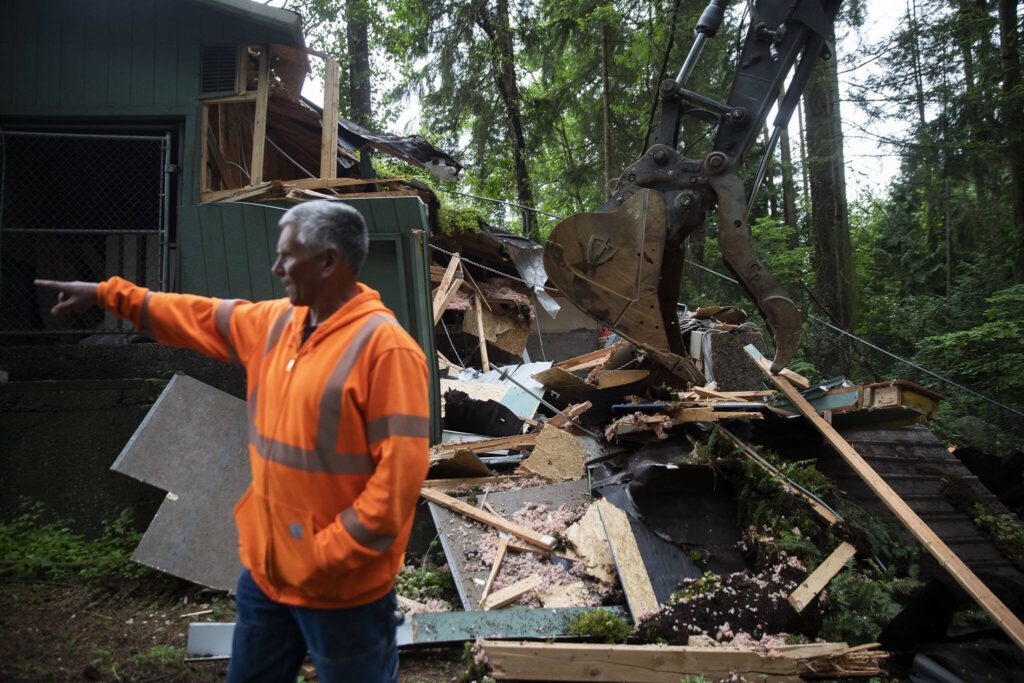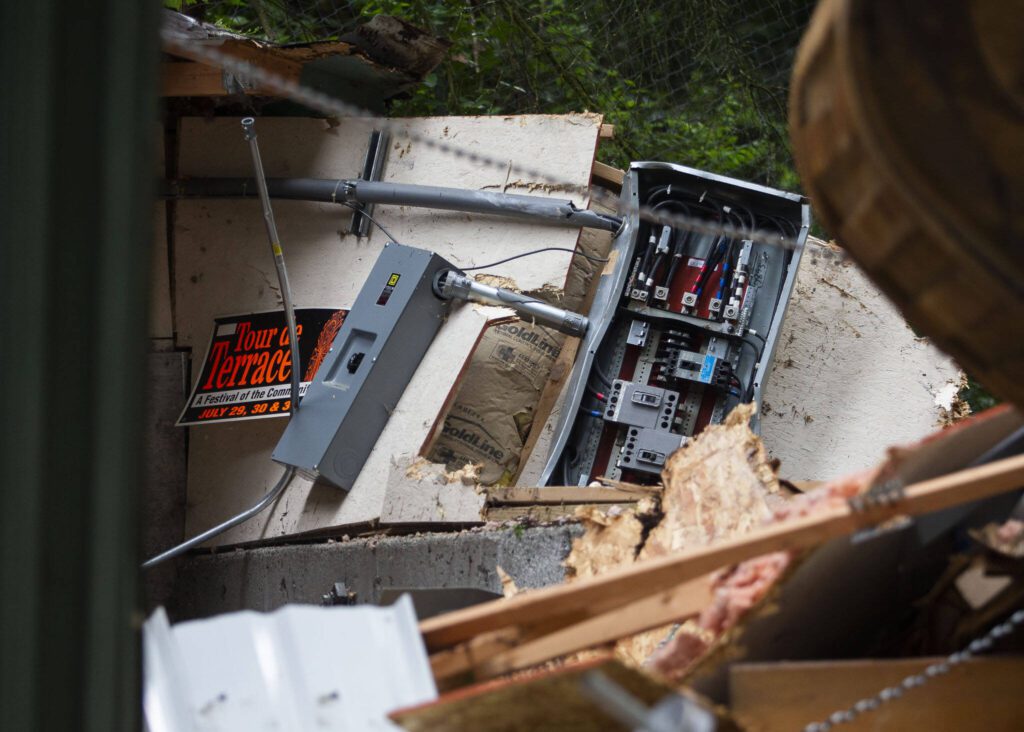MOUNTLAKE TERRACE — Bye-bye, bunkers.
What’s up with that?
For decades, the hulking green structure, dull with moss, was a ramshackle curiosity blocking the trail that leads past the Mountlake Terrace police station into the urban forest.
Not anymore.
The structure, colloquially known as the bunkers, was smashed to smithereens last week. A trackhoe excavator crunched the contents into rubble.
For several hours on razing day, the trackhoe operator maneuvered the boom, the bucket’s teeth chomping like a hungry T. rex. The roar made Veterans Memorial Park sound more like Jurassic Park.
The demolition is part of the Transit Connection Corridor Project to improve access from the Civic Campus through the woods for recreation and the incoming light rail.
The bunkers were in the way of progress.
“They were fenced off. It was not welcoming. It was junky,” said Rikki Fruichantie, a city spokesperson.
Fruichantie described the bunkers as “vestigial,” a remnant through evolution not serving a purpose anymore, like a human appendix or the wings of flightless birds.
Sources say the bunkers started as an open concrete structure built circa the 1970s for storage of materials such as gravel and water main pipe and fittings. The exact history is lost in the sands of time.
The shabby green units were later built atop the concrete base and used by various departments to store stuff, kept just in case.
“Like things you put in your garage or attic that you don’t really need, but you keep because you think someday you might,” said Jeff Betz, the city’s parks and recreation director.
The eyesore held a storehouse of history, including but not limited to:
• User manuals for appliances long forgotten.
• Doorknobs and tiles not made anymore, but potentially a perfect fit when something breaks in the old, funky pool pavilion.
• A ’70s crystal punch bowl with cups. A newer punch bowl has taken its place at City Hall.
• A 600-pound glass panel that was once a prominent art display.
• Lubricant oil dated 1966.
• A dictionary printed in the early 1900s, because Portugal’s flag changed then, and the book has the older flag.
• Old police bikes and safes.
And a lot of cobwebs, Betz said.
“At one point a number of years ago we had to move evidence out of there and mitigate the mold,” Police Chief Pete Caw said.
The bits and bobs are government property, thus not up for grabs for personal use. Not even that pre-1910 dictionary with outdated flags or a broken tile. Not even a cobweb.
Items deemed useful were rescued before the demolition.
City Clerk Jennifer Joki and Rebecca Guillen, public records officer, made it their mission to recover any items needed for public disclosure or for the historical records. They salvaged 2½ boxes of records from the bunkers.
“It was dark, and we had to use flashlights. None of the electricity was working. It was seriously stinky,” Joki said. “On some of the records, the ink had worn off. Some were just dirty or destroyed, you couldn’t make out what they were.”
The explorers wore homemade hazmat suits.
“We had white sneakers with black trash bags on. The hillside had a black tarp with white rocks on it. We were afraid if we fell on it, we would blend in, no one would see us,” Joki said. “We had to lift the boxes full of nasty records over the chicken wire fence and back up the black tarped hill, onto the dolly, and bring it back to City Hall.”
For several hours on wrecking day last week, the clatter echoed from the park.
Rachel Ferguson heard the noise as she was leaving the library with her kids, Jakob, 2, and Madeleine, 4.
“It’s cool,” Madeleine said. “There were some scary parts, like the loud noise.”
Jakob stood fascinated by the live show of breaking boards and mass destruction.
Somewhere in the ruins were the shards of the 600-pound “Terrace Light” art installation created for Mountlake Terrace’s 50th celebration in 2004.
In its heyday, the 4-by-8-foot glass panel depicting mountains against a blue sky was displayed over the front counter of the old City Hall building, but spent most of its life shuttered in the bunkers. It requires a forklift to move.
The arts commission said it “no longer fits the city’s aesthetics.” Due to the size, weight and having nowhere to go, the only option left was to destroy the glass monolith. The city deaccessioned “Terrace Light” at an April council meeting and sentenced it to death.
In the bunker demolition, it became part of the broken, bent and smashed shreds of civilization hauled away to the landfill. Where much government property goes for eternity.
All that remains of the bunkers is the concrete base. Someday, it will be a place where people picnic, munching chips with no idea of the storied past.
Is there a person, place or thing making you wonder “What’s Up With That?” Contact reporter Andrea Brown: 425-339-3443; abrown@heraldnet.com; Twitter: @reporterbrown.
Talk to us
> Give us your news tips.
> Send us a letter to the editor.
> More Herald contact information.




























